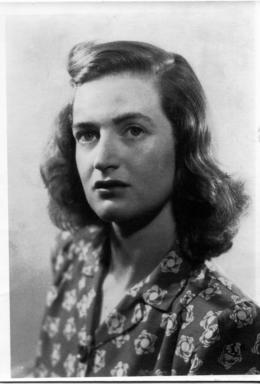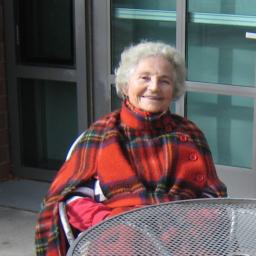|
|
The Grazian-Archive grazian-archive.com | The idea of the grazian-archive sprang to life when technical developments came across Alfred de Grazia's twenty-year-old idea of the "Living Archive," the universally accessible private archive of creative people. There existed suddenly the possibility to make the entire life's work of a person accessible to anybody, at any time, anywhere on the planet.
|
|  | | Jill Oppenheim |
| | Among the most remarkable items in the archive of Alfred de Grazia was a correspondence of over 1200 letters exchanged during Word War II between Alfred and his wife Jill Oppenheim, when both were in their early twenties, and were separated while he passed four years in American camps and overseas as an officer in a clutch of intelligence missions, most under the rubric of psychological warfare for the US Army. While Alfred kept her informed almost daily about his life as a soldier through six campaigns from Northern Africa to Germany, Jill's side of the correspondence described, with wonderful intelligence and wit, her experiences of the American home front, her first pregnancy, and the rearing of a war-time baby. This correspondence of undeniable literary and historical value had been preserved by him by one way and another despite countless moves. |
|
| In the 1990's, Alfred began digitizing this remarkable set of documents, turning for help to a mutual, long-time close friend of Jill and ourselves, Julia Bernheim, to faithfully word-process the letters from the hand-written originals. Julia was then working at the Institute for Advanced Studies in Princeton; she had been Alfred's secretary in the sixties, at the time of The American Behavioral Scientist, and was familiar with his handwriting. Jill gave her written consent to Alfred to use her letters for his archive. Tragically, as Julia's work of word-processing was nearing its end, Jill died in September 1996, from a cancer attributed to asbestos poisoning incurred working in a wartime factory,
Alfred de Grazia decided to start his personal archive project by publishing on-line this correspondence of Letters of Love and War, also as a way, most likely, of coming to terms with Jill's death. Now living in Princeton, he enlisted the help also of Syamala Jonnalagadda, who was advertising her services as a web-master; she was then tutoring others on the creation of websites.
|
|  Julia Bernheim in front of Princeton Public Library Julia Bernheim in front of Princeton Public Library |
|
| The grazian-archive website went online on Valentine's Day 1997, less than six months after Jill's passing. It got off with flying colors as the Chicago Sun-Times published a feature about the correspondance, with an interview of Alfred, and as a result the new grazian-archive.com site received right from the start an unexpectedly high number of connection clicks, which propelled it up to an enviable position with search engines like Google.
|
| | | Websites were less numerous then, no more than two million world-wide, which has consistently put the grazian-archive at an advantage as time went on, and as the Google model of search engines became prevalent. This advantage was bolstered as the letters continued to be added steadily over the next two years and a faithful following of readers was established.
Simultaneously, Alfred entered a deal with Syamala and her husband Krishna to have all of his published books put on line on the new grazian-archive site, taking advantage of their contacts in Bangalore, India, from where they both originated, to outsource the work to be done in preparation. Alfred wanted to go for scanning, but scanning was a painstaking process at the time and the results of Optical Character Recognition (OCR) were still dismally poor, and Krishna advised against it: there were so many errors per page that everything needed to be proof-read very carefully; it would have been unrealistic to expect a consistently attentive and serious editing of so large an amount of material, and, moreover, the cost would have been prohibitive. He advised having the books word-processed and spell-checked instead. Boxes of books and articles - already in printed form and previously published - were sent to Bangalore, then put on line during the following year. Although the result of the work was satisfactory at first glance, we were soon to discover frauds, which nobody had foreseen: paragraphs and sentences had occasionally been shortened by the typists in order to get ahead quicker with their work load.
This convinced us that scanning was the only way to proceed.
By the end of 1999, having spent part of the year in Greece for several decades, we decided to spend even more time in Europe. A young German programmer and electricity buff, Chris Meyer-Rudolphi, whose parents were our friends and also spent their summers in Naxos, had decided to live the "alternative" life on the island and was looking for an activity. He had been helping Alfred de Grazia for several years. He joined the team producing the grazian-archive and putting on line Alfred's published work. The scanning was undertaken by Chris Meyer-Rudolphi and various helpers under his supervision. Successive problems were addressed on a trial and error basis, various ways of dealings with the archive were tried out. Julia Bernheim, in the wake of her work on the "Letters of Love and War," agreed to word-process the extensive hand-written journals of Alfred as well.
These early years were pioneering, and dogged with problems. The human resources were limited. Alfred de Grazia was heavily involved in adding creatively to his life's work, and therefore to his archive, and I was pursuing my own writing. Alfred was financing his own research, and financial resources for the archive were limited to the current income of Alfred from his retirement benefits and a small amount of savings, and in part from an inheritance from my grandmother.
In 2001, the newly created Mainwaring Archives Foundation purchased Alfred de Grazia's physical archive on Quantavolution, which provided a financial impetus for the ongoing work on the grazian-archive. From 2002, Alfred de Grazia started up, together with Prof. Emilio Spedicato, a pilot project of an Institute of Quantavolution at the University of Bergamo, near Milan, in Italy. The University of Bergamo appointed Alfred Honorary Professor of Social Theory in the Department of Mathematics and Informatics.
That year, he left the United States practically for good, becoming a resident of Italy and Greece, then of Greece and France, and Chris Meyer-Rudolphi became the sole web-master of the grazian-archive. That same year, thanks to a European Union development program, high-speed internet connections reached the island of Naxos, well ahead of even urban areas of Italy or France. The ease of communication generally increased and running a fair-sized website out of the island was no longer so challenging.
Another circumstance which continued working in favor of the grazian-archive endeavor, was the constant improvement, from 1997, in the technology of scanning and especially in the quality of OCR programs. The early shortcomings of OCR gave rise to particular, clever solutions which proved advantageous over time - such as publishing corresponding photos along with the fully searchable OCR version.
As most of the published books of Alfred de Grazia had been now published on line, the unpublished, unprinted materials had to be word-processed in turn, in keeping with the original, ambitious project of publishing the archive in its totality. Beginning in 2005, contact was made with M. Martin Stefanov, in Sofia, who was just finishing his degree in mathematics at the University of Sofia and was working as a junior manager at a printing plant there. Martin was the son of Prof. Stefan Stefanov, head of the Department of Fluid Mechanics at the Bulgarian Academy of Science, whom we had come to know in Bergamo where he had been invited by Prof. Spedicato.
We were making forays into a yet more ambitious field, of providing a version of the archives which would not only be put on line, but also could be printed in all and in part. Also. the possibilities of creating printed versions, as well as CD and DVD versions, which could be distributed to major libraries, was also being explored. Martin Stefanov took up the task to scan the remainer of the archive, including the considerable correspondence of Alfred, as well as a voluminous amount of notes, articles, copybooks, brouillons, first and early drafts, etc. All this was to be carried out over time in Bulgaria, where the work was well and reliably done. This work is continuing.
Over the years, the grazian-archive has been attracting well over two million hits a year. And it is still very much a "work in progress..." Half of its materials were still awaiting scanning. Although I cannot go into the matter here, I would point out that we by no means were exercising all the useful features of archiving by the new methods of electronics and digitalization. Nor have I gone into the external relations of the archive, the clientele, or the seemingly endless research notes that could be elicited from the materials, and other functions that continue to occur. The "Living Archive" has scarcely imaginable possibilities and utilities. |
|
Ami de Grazia, April 2011 |
| |
|
| Copyright © 2011. Tous droits réservés. mercredi 11 avril 2012 Ami de Grazia, webmaster | Contact: metronax@gmail.com |
|
|
|

